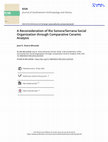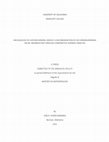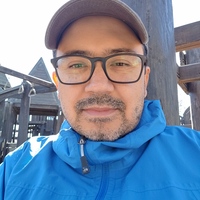Papers by Jose R Vivero Miranda

Traditionally, interpretations of Rio Sonora/Serrana's social organization often focus on long-di... more Traditionally, interpretations of Rio Sonora/Serrana's social organization often focus on long-distance trade, relying heavily on ethnohistorical sources. The local ceramic tradition—primarily brownware with textured motifs—has been overlooked in socio-political studies. This research proposes a typology of textured decoration to explore social organization, identity, and interactions across the Sonora, Moctezuma, and Fronteras Valleys. Findings reveal distinct decorative patterns unique to each valley, with variations at inter-valley, intra-valley, and intra-site scales. Patterns in decoration are interpreted as expressions of identity and social dynamics, which aid in assessing existing models of social organization. Public architecture in the Sonora Valley is interpreted as spaces for social gatherings and integration among nearby groups. While this analysis enriches existing social organization models, it also enhances understanding of Pre-Colonial and Proto-Colonial groups in eastern Sonora, providing a refined framework for interpreting socio-political integration in the region and evaluating data from neighboring regions in the future.

This research is part of efforts to expand archaeological knowledge of eastern Sonoran-Sierra Mad... more This research is part of efforts to expand archaeological knowledge of eastern Sonoran-Sierra Madre (Serrana) groups. The study intends to provide an additional perspective regarding socio-political integration of the several population centers in the Sonoran Sierra Madre. Specifically, this study case aims to exemplify if social dynamics of the region during the Late Ceramic Period (AD 1100-conctact) is reflected in decorative textured treatments on ceramic. The research consists of qualitative and quantitative analyses of decorative treatment attributes and layouts. Original analyses are undertaken of an assemblage from the Sonora Valley and compared to data previously collected from the Fronteras and Moctezuma valleys. In addition to the regional comparison, the Sonora sample is analyzed for variation at the scales of intra- and inter-site. Insights are presented that evaluate whether the scale of perceived variation is consistent with the current interpretations regarding the scale of socio-political integration. The study also offers a first approximation of the sorts of social identities represented in the textured treatments of the region.
Conference Presentations by Jose R Vivero Miranda
The 16th-century European arrival to Mexico led to massive social, cultural, and economic transfo... more The 16th-century European arrival to Mexico led to massive social, cultural, and economic transformations in the indigenous worlds. In Mexico, the Spanish commonly employed forced migrations, especially in highly populated areas. While ethnohistoric accounts are one important source of information to understand these forced migration patterns and the social and cultural transformations they caused, for northern Sinaloa, there are few records. This poster summarizes the results of archaeological research conducted in this region, offering a glimpse of this time period, which suggests a massive forced movement of people. A GIS analysis is used to better understand the consequences of colonial practices.

The Guasave region in Northwest Mexico, situated in the borderland between Mesoamerica and the Gr... more The Guasave region in Northwest Mexico, situated in the borderland between Mesoamerica and the Greater Southwest, has long been a subject of debate. By AD 750, Mesoamerican traditions began to spread into Northwest Mexico, reaching Guasave by AD 1100 and gradually fading by AD 1450. This cultural diffusion led to the adoption of foreign elements visible only in specific areas of interaction and select aspects of material culture, notably observed in the funerary practices at El Ombligo (belly button) burial mound site in Guasave. However, questions regarding the local transformations prompted by this phenomenon in Guasave remain unanswered. This research utilizes Social Network Analysis to examine the funerary program at El Ombligo site from a local perspective, aiming to shed light on the social changes experienced by the local Huatabampo culture in Guasave following the introduction of foreign symbols and materials in northern Sinaloa.











Uploads
Papers by Jose R Vivero Miranda
Conference Presentations by Jose R Vivero Miranda